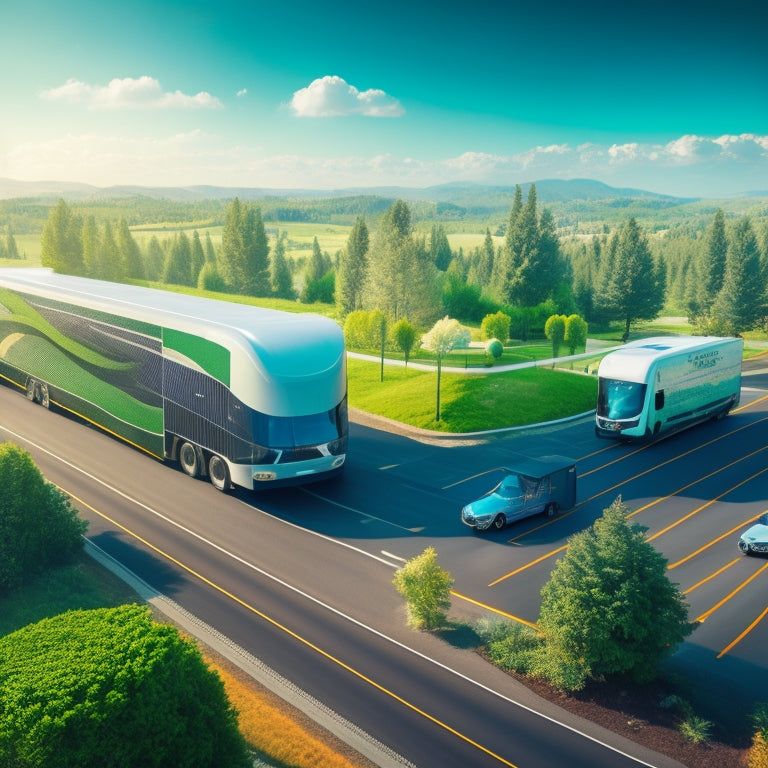
Renewable Energy Conversion Kits for Fleet Vehicles
Share
You're considering shifting your fleet vehicles to renewable energy conversion kits, which can greatly reduce your carbon footprint, lower operational expenses, and contribute to climate leadership. To achieve this, you'll need to choose from various solar panel installation options, such as roof-mounted or tilt-mounted systems. Electric motor upgrades can also decrease energy consumption and emissions. Before making the switch, consider factors like vehicle compatibility, integration, and maintenance requirements. As you explore the world of renewable energy conversion kits, you'll discover customizable options, future technology advancements, and innovative solutions to optimize your fleet's performance.
Key Takeaways
• Renewable energy conversion kits can reduce fleet emissions output and decrease greenhouse gas emissions, contributing to climate leadership.
• Customizable conversion kits are available, tailored to operational needs, environmental goals, and fleet prioritization, with options for partial or full conversions.
• Electric motor upgrades can boost motor efficiency, enhance vehicle performance, and require less maintenance than traditional engines, reducing operational expenses.
• Integration considerations for renewable energy conversion kits include vehicle inspections, fleet management, electrical and mechanical integration, and compatibility assessments.
• Regular maintenance and repair are crucial for optimal performance, with considerations including regular inspections, preventive overhauls, specialized training, and documentation.
Benefits of Renewable Energy Conversion
By integrating renewable energy conversion kits into your fleet vehicles, you can markedly decrease greenhouse gas emissions and lower your carbon footprint. This reduction in emissions not only benefits the environment but also contributes to your organization's Climate Leadership. As a fleet operator, you'll be taking a notable step towards Energy Independence, reducing reliance on fossil fuels and minimizing your impact on the environment.
By adopting renewable energy conversion kits, you'll also experience notable cost savings. With lower fuel consumption and reduced maintenance needs, you'll see a considerable decrease in operational expenses. Additionally, government incentives and tax credits may be available for fleets that adopt eco-friendly technologies, further offsetting the initial investment.
Renewable energy conversion kits also enhance your fleet's safety profile. With fewer moving parts and reduced heat generation, the risk of mechanical failure and fires is significantly lower. By opting for renewable energy conversion kits, you're not only reducing your environmental impact but also ensuring a safer operating environment for your drivers and other road users.
Types of Fleet Vehicle Conversions
You can choose from various types of fleet vehicle conversions, each tailored to specific operational needs and environmental goals. Depending on your fleet's unique requirements, you can opt for partial or full conversions, which involve replacing or augmenting existing powertrains with renewable energy systems.
Fleet prioritization plays a significant role in determining the most suitable conversion type, as it helps identify the most critical vehicles to convert first. Vehicle classifications also influence the conversion process, as different classes have distinct energy demands and operational patterns. For instance, Class 8 trucks require more powerful systems than lighter-duty vehicles, while buses may necessitate customized solutions for their unique energy needs.
By understanding your fleet's operational dynamics and prioritizing conversions accordingly, you can facilitate a smooth shift to renewable energy. This strategic approach enables you to maximize the benefits of fleet vehicle conversions while minimizing disruptions to your operations.
Solar Panel Installation Options
When integrating solar panels into your fleet vehicles, roof-mounted installations offer a sleek, aerodynamic design that minimizes wind resistance while providing maximum energy harvesting. This setup is ideal for fleet vehicles that require a low profile, such as delivery vans or emergency response vehicles. However, you may also consider alternative installation options to suit your specific needs.
| Installation Option | Benefits |
|---|---|
| Roof-Mounted | Aerodynamic design, maximum energy harvesting |
| Tilt-Mounted | Adjustable panel angles for best energy collection |
| Track-Mounted | Easy installation and removal, suitable for varying roof sizes |
| Folding-Mounted | Compact storage, ideal for emergency response vehicles |
When selecting an installation option, consider factors such as roof rack compatibility, panel angles, and energy harvesting potential. Make sure that your chosen installation method meets safety standards and adheres to local regulations. By carefully considering these factors, you can optimize your solar panel installation for top energy efficiency and safety.
Electric Motor Upgrade Benefits
Upgrading your fleet vehicles with high-efficiency electric motors can greatly reduce energy consumption and greenhouse gas emissions, allowing you to meet stringent environmental regulations and improve your bottom line.
By replacing traditional internal combustion engines with electric motors, you'll experience a significant boost in motor efficiency. This means you'll get more power while using less energy, reducing your overall operating costs.
A high-efficiency electric motor upgrade can provide a performance boost of up to 20% compared to traditional motors. This increase in power and efficiency translates to faster acceleration, improved towing capacity, and enhanced overall vehicle performance.
Additionally, electric motors require less maintenance than traditional engines, reducing downtime and extending the lifespan of your fleet vehicles. With an electric motor upgrade, you can expect fewer oil changes, reduced brake wear, and extended tire life.
Reducing Fleet Emissions Output
When evaluating your fleet's emissions output, you'll want to explore strategies that minimize environmental impact.
By implementing emission reduction strategies, you can notably decrease your fleet's carbon footprint and contribute to greenhouse gas mitigation.
Emission Reduction Strategies
By implementing emission reduction strategies, you can greatly decrease your fleet's environmental impact and reduce greenhouse gas emissions by up to 75%. One key approach is to focus on fuel efficiency. By optimizing routes, maintaining vehicles, and promoting eco-driving practices, you can notably reduce fuel consumption.
Additionally, consider upgrading to more fuel-efficient vehicles or retrofitting existing ones with fuel-saving technologies.
Government incentives can also play an important role in your emission reduction strategy. Many governments offer tax credits, grants, or rebates for fleets that adopt cleaner technologies or alternative fuels. By taking advantage of these incentives, you can offset the costs of shifting to a more sustainable fleet.
Moreover, implementing emission reduction strategies can also lead to cost savings through reduced fuel consumption and lower maintenance costs. By adopting a proactive approach to reducing emissions, you can't only minimize your fleet's environmental footprint but also improve your bottom line.
Greenhouse Gas Mitigation
Your fleet's greenhouse gas emissions output can be greatly reduced through the strategic deployment of renewable energy conversion kits on your vehicles. By shifting to cleaner energy sources, you can substantially decrease your carbon footprint and contribute to a more sustainable future.
To achieve effective greenhouse gas mitigation, consider the following strategies:
-
Carbon pricing: Implement a carbon pricing mechanism to assign a monetary value to your fleet's emissions, providing a financial incentive to reduce emissions.
-
Electrification of routes: Identify routes with high emissions output and prioritize the deployment of electric or hybrid vehicles on those routes.
-
Optimize vehicle performance: Regularly maintain and optimize your vehicles' performance to minimize energy consumption and reduce emissions.
- Climate resilience planning: Develop a climate resilience plan to ensure your fleet's operations can adapt to the impacts of climate change, such as more frequent extreme weather events.
Cost Savings of Renewable Energy
Switching to renewable energy conversion kits for your fleet vehicles can greatly reduce your organization's energy expenditure. By integrating renewable energy sources, such as solar or wind power, into your fleet's energy mix, you can substantially lower your reliance on fossil fuels and decrease your energy costs.
Conducting energy audits can help identify areas of inefficiency and opportunities for improvement, allowing you to optimize your energy usage and maximize your savings. Additionally, many governments offer financial incentives for organizations that invest in renewable energy, such as tax credits or grants, which can further offset the cost of implementation.
Vehicle Compatibility and Integration
You'll need to verify that the renewable energy conversion kit is compatible with your fleet vehicles' existing systems and infrastructure. This is essential to guarantee a seamless integration of the kit with your vehicles' electrical systems, engines, and other components. A thorough assessment of your fleet's specifications, including vehicle make, model, and year, will help identify potential compatibility issues.
To guarantee a smooth integration, consider the following factors:
-
Vehicle Inspections: Conduct thorough inspections to identify any potential electrical system modifications required for the conversion kit.
-
Fleet Management: Review your fleet management software and systems to ensure compatibility with the renewable energy conversion kit's data tracking and monitoring capabilities.
-
Electrical System Integration: Verify that the kit's electrical components are compatible with your vehicles' electrical systems, including voltage, current, and power requirements.
- Mechanical Integration: Ensure the kit's mechanical components, such as mounting hardware and brackets, are compatible with your vehicles' chassis and body.
Customizable Conversion Kit Options
Renewable energy conversion kits can be tailored to meet specific fleet requirements through customizable options that accommodate diverse vehicle configurations and operational needs. As you consider shifting your fleet to renewable energy, you'll want to make sure the conversion kit meets your unique requirements. That's where kit customization comes in.
By selecting from a range of options, you can create a bespoke solution that addresses your fleet's specific needs. Kit customization offers fleet flexibility, allowing you to adapt the conversion kit to your vehicles' specific characteristics, such as engine type, battery size, and electrical system requirements. This tailored approach ensures a seamless integration with your existing fleet infrastructure, minimizing downtime and maximizing efficiency.
With customizable conversion kits, you can optimize your fleet's performance, reduce emissions, and improve overall safety. By choosing a kit that's tailored to your fleet's needs, you'll be able to achieve a smoother shift to renewable energy and reap the benefits of a more sustainable fleet operation.
Maintenance and Repair Considerations
Your fleet's maintenance and repair routines will need to adapt to the unique requirements of renewable energy conversion kits to guarantee peak performance and minimize downtime. As you integrate these kits into your fleet, it's important to prioritize regular inspection and preventive overhaul to ensure best performance and minimize downtime.
Here are some essential maintenance and repair considerations to keep in mind:
-
Regular Inspection: Schedule regular inspections to check for signs of wear and tear, corrosion, or damage to the conversion kit components, electrical connections, and wiring.
-
Preventive Overhaul: Perform routine overhauls to replace worn-out components, clean or replace air filters, and inspect electrical systems to prevent faults.
-
Specialized Training: Ensure your maintenance team receives specialized training to handle the unique requirements of renewable energy conversion kits.
- Documentation and Record-Keeping: Maintain accurate records of maintenance, repairs, and inspections to track performance, identify trends, and optimize your maintenance strategy.
Future of Renewable Fleet Technology
As fleet operators increasingly prioritize sustainability, the demand for innovative, high-performance renewable energy solutions is driving the development of next-generation fleet technologies that can efficiently harness and convert renewable energy sources. You're likely to see significant advancements in energy storage, power electronics, and system integration. These advancements will enable fleets to seamlessly shift between different energy sources, optimize energy usage, and reduce emissions.
Government incentives will play a vital role in accelerating the adoption of renewable fleet technologies. You can expect governments to offer subsidies, tax credits, and other benefits to encourage the adoption of eco-friendly fleet solutions.
However, infrastructure challenges will need to be addressed to support the widespread adoption of renewable energy. You'll need to take into account the availability of charging infrastructure, grid capacity, and energy storage solutions.
As the industry continues to evolve, you can expect to see new business models emerge, such as energy-as-a-service and fleet-as-a-service. These models will enable you to access renewable energy solutions without significant upfront costs. By staying ahead of the curve, you can secure a sustainable and profitable future for your fleet operations.
Frequently Asked Questions
Can I Convert My Existing Fleet Vehicles to Renewable Energy?
You can explore converting your existing fleet vehicles to renewable energy, potentially reducing fuel costs and minimizing environmental impact, but it's important to weigh the feasibility and safety of such a conversion against the required investment.
How Long Does a Typical Conversion Kit Installation Take?
Did you know that 70% of fleet conversions are completed within a week? Typically, you can expect a skilled technician to complete a conversion kit installation in 2-5 days, thanks to an efficient workflow that guarantees a safe and timely process.
Are There Any Government Incentives for Renewable Fleet Conversions?
You'll find various government incentives for adopting eco-friendly fleet conversions, including federal tax credits, federal grants, and state rebates, which can substantially offset conversion costs and support your sustainable fleet management goals.
Can I Customize a Conversion Kit for My Specific Fleet Needs?
You can customize a conversion kit by undergoing a fleet assessment to determine your energy requirements, which enables the creation of customized solutions tailored to your vehicle profiles, ensuring a thorough fleet analysis meets your unique energy demands.
Do Renewable Energy Conversion Kits Void Vehicle Warranties?
"Like a puzzle, you're fitting together the pieces of sustainable fleet management. When it comes to renewable energy conversion kits, you're right to wonder: do they void vehicle warranties? Rest assured, most manufacturers won't void warranties due to kit installation, as long as you follow their guidelines, maintaining manufacturer liability and warranty protection."
Related Posts
-

3 Earth-Loving Furniture Tips for Energy-Smart Homes
When furnishing your energy-smart home, you have the power to reduce your carbon footprint greatly by making consciou...
-

What Water-Saving Gardens Complement Electric Vehicle Ownership?
As you pair your electric vehicle with a water-saving garden, you're not only reducing your carbon footprint but also...
-

7 Top HEPA Filters for Green Building Projects
You need a reliable HEPA filter for your green building project that aligns with your sustainable goals and guarantee...


